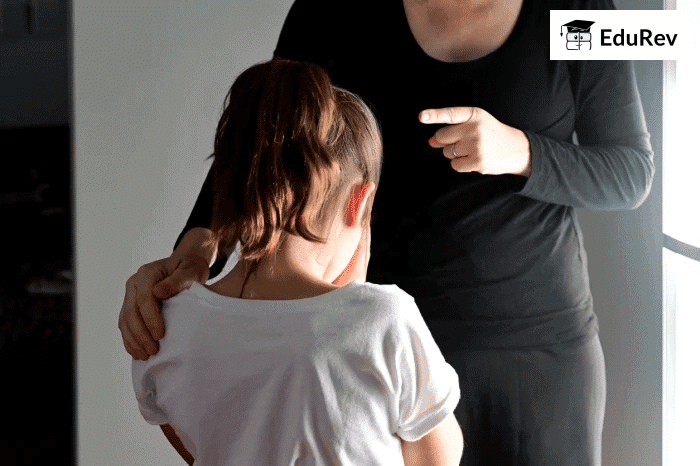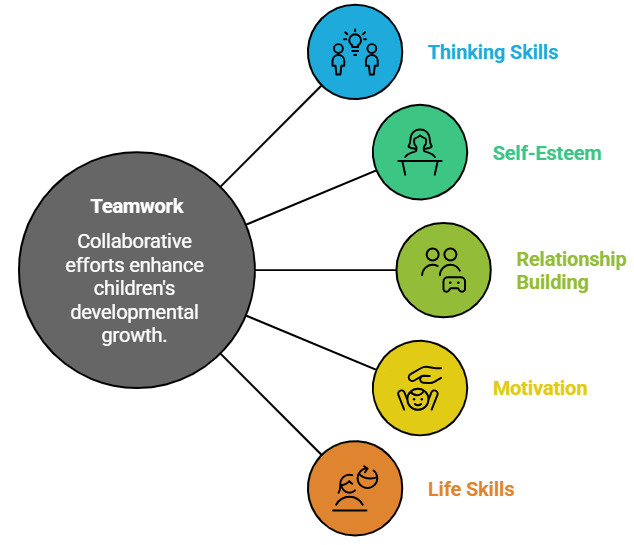Beyond Commands: Rethinking How We Talk to Our Children | Guide for Mindful Parenting in 2025 - LKG PDF Download
| Table of contents |

|
| Why Commands Don’t Always Work |

|
| A Better Way: Talk as a Team |

|
| Why This Helps Kids |

|
| How to Start |

|
| Handling Problems |

|
| Real-World Example |

|
| Why It’s Worth It |

|
Why Commands Don’t Always Work
Telling kids what to do, like “Do your homework!” or “Clean your room!” seems like a fast way to get things done. But it can cause problems because it limits kids to just listening or not listening. This can stop them from growing and make them feel disconnected from you.
- Kids Feel Controlled: When you give orders, kids might feel like they don’t have a voice. A study in the Journal of Child Development found that kids with parents who use lots of commands often feel less confident and struggle to solve problems on their own. They might think, “I only do this because I’m told to,” which can lower their self-esteem over time.
- Kids Might Push Back: Orders can make kids want to argue or ignore you, especially as they get older and want more freedom. A study in Developmental Psychology showed that teens who feel bossed around are more likely to act out, like refusing to do chores or talking back. For example, if you say, “Go to bed now!” a teen might stay up just to feel in control.
- Kids Miss Learning: When you tell kids exactly what to do, they don’t get to practice thinking for themselves. A study in Parenting: Science and Practice found that kids who are always given orders are less likely to develop skills like planning or making smart choices.
For instance, if you say, “Put your toys away,” they might do it but not learn why keeping things tidy matters.
Commands might work for a moment, but they don’t help kids learn to think, make choices, or feel good about themselves.

A Better Way: Talk as a Team
Instead of giving orders, try working together with your kids. This makes them feel included and teaches them important skills. Here are five ways to do it, with extra details and examples for different ages:
1. Ask Questions
Instead of saying, “Put your shoes away,” ask, “Where can we put your shoes so the house stays neat?” Questions make kids think and feel like their ideas matter. They also learn to solve problems.
- For Younger Kids (3–6): Keep questions simple. For example, “Where do your crayons go when you’re done?” This helps them feel proud when they figure it out.
- For Older Kids (7–12): Ask bigger questions, like, “How can we keep your backpack organized so you can find your homework?” This encourages planning.
- For Teens (13+): Try, “What’s a good way to manage your school stuff so you’re ready for the week?” This respects their need for independence.
Tip: If a kid doesn’t answer right away, give them a hint, like, “Maybe the shoes could go by the door?” This keeps it collaborative without taking over.
2. Explain Why
Tell kids why a task matters. Instead of “Wash the dishes,” say, “Washing dishes keeps our kitchen clean so we can cook yummy food together.” When kids understand the reason, they’re more likely to help out.
- For Younger Kids: Say, “We clean up toys so we don’t trip and can play safely.” Keep it short and clear.
- For Older Kids: Try, “Doing your homework now means you’ll have more time to play games later.” Connect it to something they like.
- For Teens: Explain, “Keeping the car clean makes it nice for everyone who rides in it, including you and your friends.” This shows how it benefits them.
Added Detail: A 2020 study in Child Development found that kids who understand the “why” behind tasks are more motivated to do them without being told. Explaining also teaches them to think about how their actions affect others, like keeping a shared space nice for the family.
Tip: If a kid asks, “Why do I have to do this?” don’t just say, “Because I said so.” Try, “Let’s talk about why this helps us all.”

3. Give Choices
Let kids pick between a couple of options. Instead of “Do your homework now,” say, “Do you want to do homework now or after a snack?” Choices make kids feel like they have some control, which makes them more willing to listen.
- For Younger Kids: Offer two simple choices, like, “Do you want to wear the red shirt or the blue one?” Too many options can confuse them.
- For Older Kids: Try, “Do you want to clean your room before or after watching a show?” This gives them flexibility within limits.
- For Teens: Say, “Would you rather do your chores this afternoon or tomorrow morning?” This respects their growing need for independence.
Added Detail: A 2018 study in Journal of Family Psychology found that giving kids choices increases their sense of responsibility and reduces arguments. Choices also help kids practice decision-making, which they’ll need for things like managing time in school or handling peer pressure.
Tip: Make sure both choices work for you. For example, don’t offer, “Do you want to do your homework or not?” because not doing it isn’t an option.

4. Use “We” Words
Make tasks feel like a team effort. Instead of “Clean your room,” say, “Let’s tidy the room so it feels nice for us.” This makes kids feel like you’re working together, not just telling them what to do.
- For Younger Kids: Say, “Let’s put the blocks away so we can build something new tomorrow.” You can even pick up a few blocks to show you’re helping.
- For Older Kids: Try, “Let’s get the table set so we can eat dinner together.” This makes it feel like a family goal.
- For Teens: Say, “Let’s figure out a plan to keep the house organized this week.” This invites them to share ideas.
Added Detail: Using “we” words builds a sense of family unity. A 2022 study in Family Relations found that kids who feel like part of a team at home are more cooperative and feel closer to their parents.
Tip: For young kids, work alongside them sometimes, like folding laundry together. For teens, let them take the lead on part of the task to build trust.
5. Listen to Their Feelings
If a kid is upset or not listening, notice how they feel. Instead of “Stop whining and get ready for bed,” say, “You seem tired. Is bedtime feeling tough? Let’s make it easier.” This shows you care and helps them calm down.
- For Younger Kids: Say, “You look sad about leaving the park. Want to talk about it?” This helps them name their feelings.
- For Older Kids: Try, “Homework seems hard today. Is something bothering you?” This opens the door to talk.
- For Teens: Say, “You seem stressed. Want to tell me what’s going on?” This shows you respect their emotions.
Added Detail: A 2019 study in Emotion found that kids whose parents acknowledge their feelings are better at managing emotions and solving problems. This approach also reduces tantrums in younger kids and defiance in teens because they feel understood.
Tip: If a kid is too upset to talk, give them a moment to calm down, then try again. For example, “Let’s take a deep breath and talk about what’s going on.”

Why This Helps Kids
Talking as a team does more than get tasks done. It helps kids grow in big ways:
- They Learn to Think: Making choices and answering questions helps kids practice solving problems. A 2020 Child Development study found that kids who get to make decisions are better at handling challenges, like figuring out a tough school project.
- They Feel Important: When you listen to their ideas and explain things, kids feel like they matter. This builds confidence and makes them more likely to try new things, like joining a club or speaking up in class.
- You Get Closer: Working together cuts down on fights and builds trust. Kids feel like you’re on their side, which makes them more open with you. A 2021 study in Journal of Family Psychology found that kids who feel respected by parents are happier at home.
- They Want to Do Things: Instead of doing stuff just to avoid trouble, kids start to see why tasks matter. A 2018 study in Educational Psychology Review says this helps them do better in school and get along with friends because they’re motivated from within.
- Added Detail: Life Skills: This approach teaches kids skills they’ll use forever, like communicating, making decisions, and working with others. For example, a teen who learns to plan chores at home might be better at managing a part-time job later.

How to Start
The article says to start small, which is perfect. Here’s a detailed plan to try this out:
- Pick One Order to Change: Choose something you say a lot, like “Brush your teeth.” Try, “Do you want to brush now or after your story?” Start with one thing a day to get used to it.
- Watch What Happens: Notice how your kid reacts. Do they smile, answer your question, or do the task more willingly? For example, if you ask, “Where should your jacket go?” and they hang it up happily, that’s a win.
- Keep Your Voice Friendly: Use a warm, calm tone. If you sound annoyed, kids might shut down. Practice saying things in a kind way, like you’re inviting them to join you.
- Let Kids Help with Bigger Stuff: Once you’re comfortable, involve them in bigger tasks, like picking a family dinner or planning a weekend outing. For example, ask a 10-year-old, “What’s a fun meal we could make together?” or a teen, “What’s a good activity for us this weekend?”
- Don’t Worry if You Mess Up: Changing how you talk takes time. If you say, “Go to bed!” by mistake, just try again later. Kids like when you’re real with them.

Added Detail: Track Progress: Keep a mental note or jot down how your kid responds over a week. For example, if you stop saying “Clean your room” and start saying “Let’s make the room cozy,” do they argue less? This helps you see what’s working.
Added Detail: Involve the Family: If other adults are in the house, like a partner or grandparent, share this approach with them. For example, explain to Grandma, “We’re trying to ask questions instead of giving orders to help the kids feel included.”
Handling Problems
Switching to teamwork talk can be tricky at first. Here are common issues and how to fix them, with extra details:
- It Takes Time: Talking as a team takes longer than orders, especially when you’re new at it. If you’re in a rush, it’s okay to say, “We’re late, so grab your shoes.” Save teamwork talk for calmer moments, like planning the day’s chores.
- Kids Might Not Like It at First: If kids are used to orders, they might test you or seem confused. For example, a 6-year-old might say, “Just tell me what to do!” Keep going, and they’ll get used to having a say. Try saying, “I bet you have a great idea for where your toys can go.”
- Different Ages Need Different Words: Little kids (under 5) need simple choices, like “Milk or water?” Older kids (7–12) can handle more, like “When do you want to do your homework?” Teens want respect, so ask, “What’s your plan for getting your project done?” Adjust to what they can handle.
- You Might Forget: If you’re tired or stressed, you might slip into orders, like “Get in the car!” That’s okay. Take a deep breath and try a teamwork phrase next time, like “Let’s get ready to go together.” Kids won’t mind if you’re trying.

Added Detail: When Kids Ignore You: If a kid doesn’t respond to questions or choices, stay calm. Try, “I notice you’re not ready to talk. Let’s try again in a few minutes.” This keeps it positive and gives them space.
Added Detail: Siblings or Different Personalities: If you have multiple kids, one might love choices while another resists. Tailor your approach. For a shy kid, give gentle prompts, like, “Would you like to pick first?” For a stubborn kid, try humor, like, “Should we race to see who cleans up faster?”
Real-World Example
Imagine your 8-year-old is dragging their feet on homework. Instead of “Do your homework now!” try this:
- Step 1: Notice Feelings: “You don’t seem excited about homework. Is it feeling hard today?”
- Step 2: Give a Choice: “Do you want to start with math or reading, or maybe take a 10-minute break first?”
- Step 3: Explain Why: “Finishing homework early means we can watch a movie together.” If they say it’s too hard, listen: “Math feels tough, huh? Want to do one problem together?” This makes them feel supported and keeps them moving forward.
For a Younger Kid (4 years old): If they won’t pick up toys, try, “You look like you’re done playing. Should we put the cars in the box or on the shelf? It’ll make room for tomorrow’s fun!”
For a Teen (15 years old): If they’re not doing chores, say, “You seem busy. What’s a good time for you to take out the trash? It helps keep the house nice for everyone.”
Why It’s Worth It
Talking as a team isn’t just about getting kids to listen. It’s about helping them grow into smart, confident people who can:
- Solve problems, like figuring out how to finish a project or settle a fight with a friend.
- Feel good about themselves because they know their ideas matter.
- Trust you and talk to you, which is huge as they get older and face bigger challenges, like school stress or peer pressure.
- Want to do things because they see the value, not just to avoid getting in trouble.
You’re also teaching them how to talk respectfully and work with others, which they’ll use at school, with friends, and even at future jobs. For example, a kid who learns to plan chores at home might be great at organizing a group project at school.
|
10 docs|2 tests
|
FAQs on Beyond Commands: Rethinking How We Talk to Our Children - Guide for Mindful Parenting in 2025 - LKG
| 1. Why do commands sometimes fail to work with children? |  |
| 2. How can talking as a team improve communication with kids? |  |
| 3. What are some effective strategies for starting team-based communication with children? |  |
| 4. How should parents handle problems that arise when using a team-based approach? |  |
| 5. Can you provide a real-world example of how team communication has worked in a parenting scenario? |  |




















